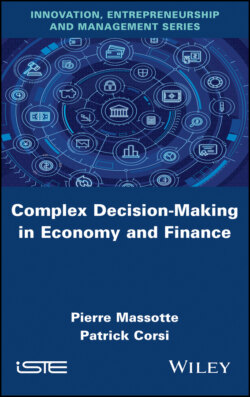Читать книгу Complex Decision-Making in Economy and Finance - Pierre Massotte - Страница 35
1.4.3. Product flow in a flexible production system
ОглавлениеConsider a flexible multi-product and multi-process workshop with duplicated equipment, feedback loops and complicated ranges.
Figure 1.2. A flexible production system
Each node or cell has its own control system and behavioral procedures. We are in a “local” environment with a limited proximity; the production rules used here concern priority management, order sequencing, alarm management (in economy and finance: alert management) in case of problems, etc.
Such a production system has been studied [BAR 96] in terms of the organization to be put in place to compensate for the disruptive effects of chaos (in the sense that they are unpredictable). Here, the chaos is essentially due to interactions between cells: oscillations created by calls, supply orders that propagate from cell to cell, going up the “line” of manufacture. They are also production or launch orders from the production management system, which will spread from one cell to another and vice versa. This will generally be done from downstream to upstream, if we operate in a pull flow. When these orders respond to nonlinear functions or influences and the phenomena are amplified, making the system sensitive to initial conditions (SIC), this induces many possible states for the production system, which can be the result of deterministic chaos. This is observed, for example, in the dynamic variation of stocks (WIP or Work In Process) throughout the “line”. The cause is due to the sequencing and amplification effects specific to the physical and logical structure of the production system. We will call this the caterpillar effect. Under these conditions, we cannot predict the behavior of such a system. Moreover, the model corresponding to a real workshop is relatively complex and cannot integrate all the parameters and assumptions: it cannot be used for steering purposes. Simulation can therefore be used to “gauge” a complex system, to evaluate trends and define the least bad strategies.
In terms of the strategies adopted, one of them consists of returning the production system to a stable state, which amounts to placing it in an area of the known and “reassuring” phase space corresponding to an area of weak bifurcations. However, its adaptability is reduced because, to reconfigure it and bring it into a new given state, it will require a lot of energy (since its inertia is greater). On the contrary, we will recommend exploiting the chaotic nature of such a system. More generally, we must seek conditions that place the production system at the limit of stable and unstable states. In an area of “weak chaos”, which is easy to achieve in nonlinear workshops, its flexibility is maximum. These concepts formed the basis of an international project called GNOSIS-VF (EU ESPRIT 28448 project) as part of the Intelligent Manufacturing Systems (IMS) program with Japan.
In this example, behavioral complexity is related to the presence and importance of interactions between the different agents that make up the production system. Here, simple deterministic functions applied to strongly linked systems can generate chaos. In this case, it is possible to control its effects by decoupling the cells from the system through a double Kanban system; this way, the value of the work in progress can be limited while leaving each cell its own elasticity and having disturbances that compensate themselves. With reduced buffer stocks, the adaptation of inputs and outputs is rather rapid thanks to self-regulatory effects; the best strategy is then to let the system evolve freely, maintaining the parameters within certain control limits.
